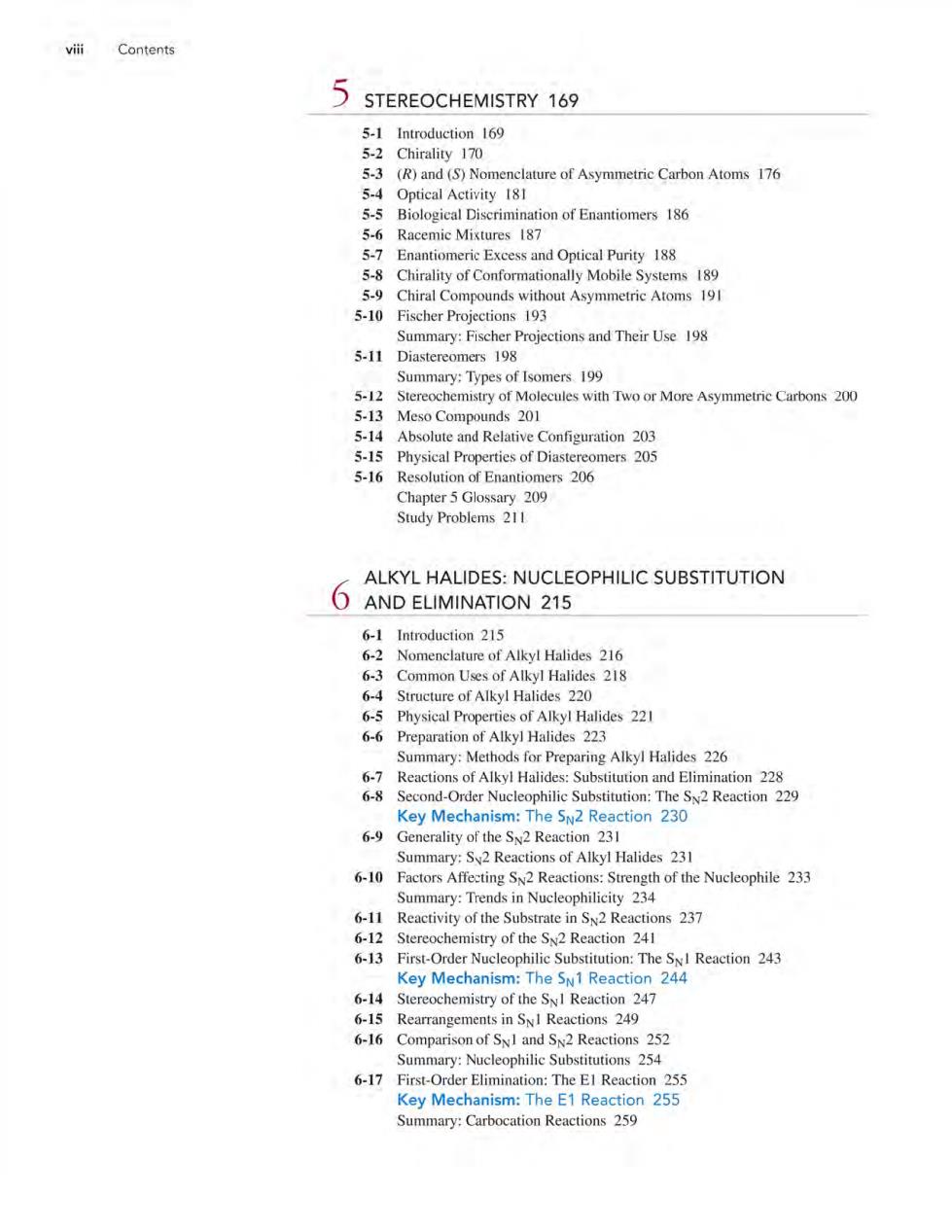正在加载图片...

Contents STEREOCHEMISTRY 169 17元 5.3 (R) ature of Asymmetric Carbon Atoms 176 ation of Enantiomers 186 56 Racemic Mixtures 187 and Optical Purity 188 5-8 Chirality of Conformationally Mobile Systems 189 5-9 Chiral Compounds without Asymmetric Atoms 191 5-10 Fischer Projections 193 Summary:Fischer Projections and Their Use 198 5-11 Diastercomers 198 Summary:Types of Isomers 199 Stereochemistry of Molecules with Two or More Asymmetric Carbons 200 eso Comp 0 nfiguration 20 mers 5-16 Study Problems 211 ALKYL HALIDES:NUCLEOPHILIC SUBSTITUTION O AND ELIMINATION 215 Introduction 215 6-3 Halides 216 Halides 218 re of Alkvl Halides 220 6-5 Physical Pr s of alkyl Halides 221 aration of Alky]Halides 223 Summary:Methods for Preparing Alkyl Halides 226 6.7 Reactions of Alkyl Halides:Substitution and Elimination 228 6-8 Second-Order Nucleophilic Substitution:The S2 Reaction 229 Key Mechanism:The SN2 Reaction 230 69 Generality of the SN2 Reaction 23 Summary:Sy2 Reactions of Alkyl Halides 231 6-10 Factors Affecting Reactions:Strength of the Nucleophile 233 n Nucleophilic city 234 keactivity of the S SN2 R ions 237 em the on ey Me SNI Reaction 243 244 6.14 of the s 47 615 nts in S.1 Reactions249 6-16 Comparison of Sxl and Sx2 Reactions 252 6.17 First-Order Elimination:The El Reaction 25: Key Mechanism:The E1 Reaction 255 Summary:Carbocation Reactions 259 viii Contents 5 STEREOCHEMISTRY 169 5-1 Introduction 169 5-2 Chirality 170 5-3 (R) and (S) Nomenclature of Asymmetric Carbon Atoms 176 5-4 Optical Activity 181 5-5 Biological Discrimination of Enantiomers 186 5-6 Racemic Mixtures 187 5-7 Enantiomeric Excess and Optical Purity 188 5-8 Chirality of Conformationally Mobile Systems 189 5-9 Chiral Compounds without Asymmetric Atoms 191 5-10 Fischer Projections 193 Summary: Fischer Projections and Their Use 198 5-11 Diastereomers 198 Summary: Types oflsomers 199 5-12 Stereochemistry of Molecules with Two or More Asymmetric Carbons 200 5-13 Meso Compounds 201 5-14 Absolute and Relative Configuration 203 5-15 Physical Properties of Diastereomers 205 5-16 Resolution of Enantiomers 206 Chapter 5 Glossary 209 Study Problems 211 6 ALKYL HALIDES: NUCLEOPHILIC SUBSTITUTION AND ELIMINATION 215 6-1 Introduction 215 6-2 Nomenclature of Alkyl Halides 216 6-3 Common Uses of Alkyl Halides 218 6-4 Structure of Alkyl Halides 220 6-5 Physical Properties of Alkyl Halides 221 6-6 Preparation of Alkyl Halides 223 Summary: Methods for Preparing Alkyl Halides 226 6-7 Reactions of Alkyl Halides: Substitution and Elimination 228 6-8 Second-Order Nucleophilic Substitution: The SN2 Reaction 229 Key Mechanism: The SN2 Reaction 230 6-9 Generality of the SN2 Reaction 231 Summary: SN2 Reactions of Alkyl Halides 231 6-10 Factors Affecting SN2 Reactions: Strength of the Nucleophile 233 Summary: Trends in Nucleophilicity 234 6-11 Reactivity of the Substrate in SN2 Reactions 237 6-12 Stereochemistry of the SN2 Reaction 241 6-13 First-Order Nucleophilic Substitution: The SN 1 Reaction 243 Key Mechanism: The SN 1 Reaction 244 6-14 Stereochemistry of the SNI Reaction 247 6-15 Rearrangements in SNI Reactions 249 6-16 Comparison of SNI and SN2 Reactions 252 Summary: Nucleophilic Substitutions 254 6-17 First-Order Elimination: TheEl Reaction 255 Key Mechanism: The E1 Reaction 255 Summary: Carbocation Reactions 259